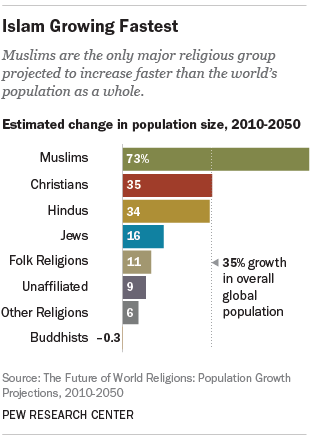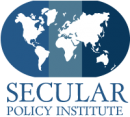The weekly column on research and trends in secular demographics
by Julie Esris
Last week an article published by Singapore newspaper Today revealed that in the Asia-Pacific region religiosity is increasing while non-religious affiliation is decreasing. In Singapore specifically, Islam and Hinduism are expected to experience the largest growth, with Islam surpassing Christianity as the second most-followed religion. Affiliation with Islam is expected to dramatically increase worldwide. In fact, a recent Pew poll predicted that if current trends continue, by 2050 there will be almost as many Muslims as Christians. In Europe alone, Muslims are predicted to comprise 10% of the population. India will still have a Hindu majority, but will surpass Indonesia as the country with the largest Muslim population. 40% of Christians will live in sub-Saharan Africa. With the exception of Buddhism, all other major religions are expected to experience an increase. Affiliation with Judaism is expected to rise 16%, Hinduism 34%, Christianity 35%, and Islam 73%. For reasons that are unclear, the Asia-Pacific region is experiencing religious growth while Europe and the United States are experiencing religious decline, but overall religious affiliation worldwide is expected to increase.
These projections are based on the current size and geographic distribution of the worldÔÇÖs major religions as well as age differences, fertility and mortality rates, and patterns in conversion. The number of adherents to Islam is expected to equal Christianity by 2050, due to fertility rates of Muslims as well as conversion into the faith. Currently, Islam is documented as the fastest growing religion, and this trend is predicted to continue. However, there are a few important flaws in this projection. The prediction that Islam will increase dramatically due to high fertility rates makes the assumption that the children will adopt the religion of their parents. As Richard Dawkins, SPI Fellow and author of The God Delusion has pointed out several times, it is just as absurd to label young children with the religious affiliations of their parents as it is to label them with their parentsÔÇÖ political affiliations: they are too young and inexperienced to have religious and political beliefs. While the Pew poll did take adult conversion into account, it also made it very clear that children of all agesÔÇöincluding infantsÔÇöwere counted in this study.
Another important issue that the study noted is that in some countries conversion is illegal, with death sometimes being the punishment for apostasy. In that case, many people who publicly identify as a particular religion might actually secretly believe in the teachings of another religion or no religion at all. Even in countries with religious freedom, some people put themselves at risk for shunning if they openly identify as atheists or even with a different religion. These factors might have skewed the poll results. It may very well be true that Islam will be almost as large as Christianity by 2050, but current trends must be determined more precisely. If nothing else, there should be a minimum age for being counted for this and similar polls. Obtaining the numbers of ÔÇ£closetedÔÇØ atheists in countries with religious freedom may be difficult but not impossible. On the other hand, getting accurate numbers from countries in which leaving the national religion is illegal is unrealistic. However, it is important to keep these and other aspects in mind when reading and interpreting this and other similar studies.
